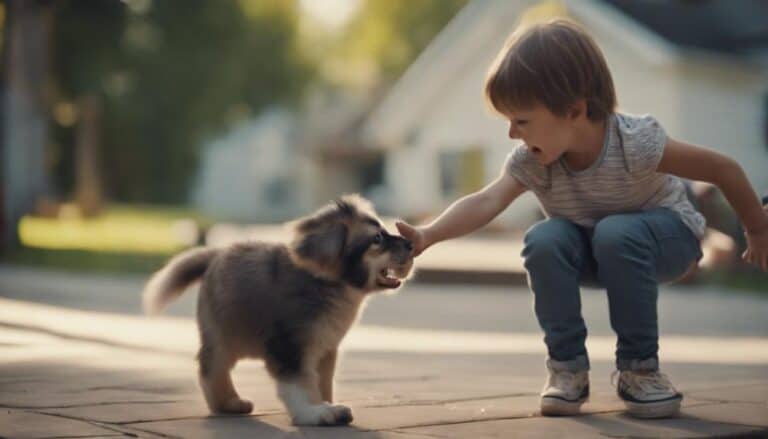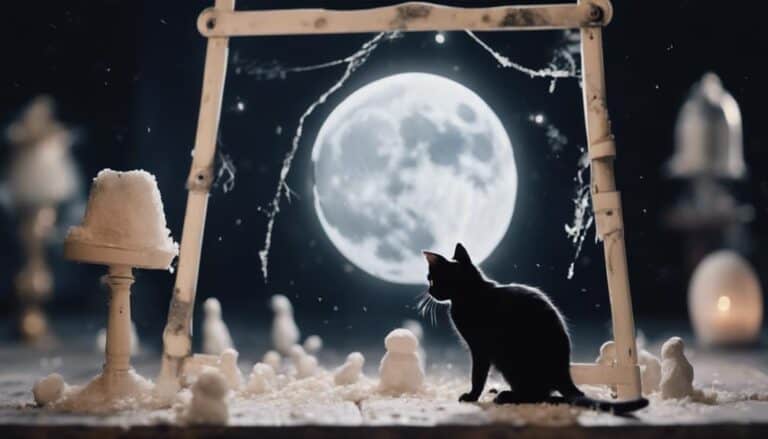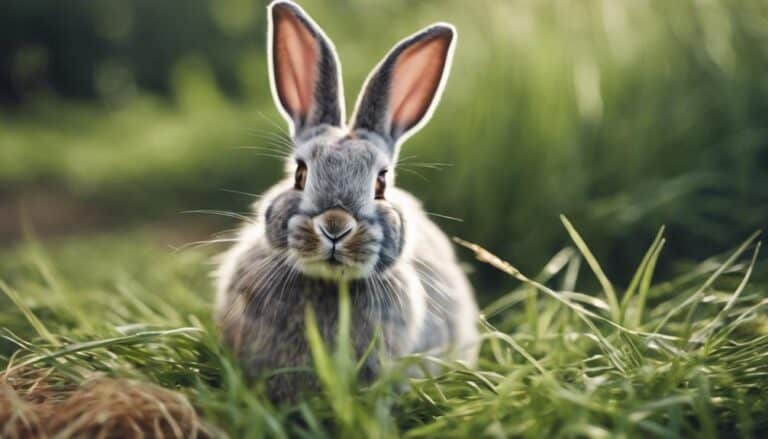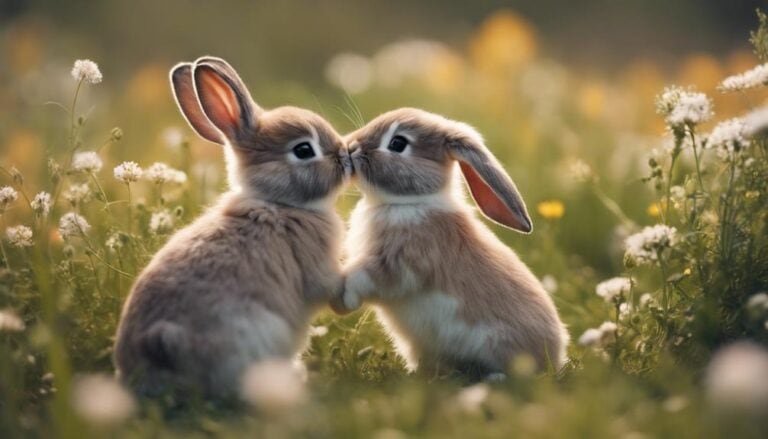Have you ever wondered if bunnies can see what's right in front of them?
The answer might surprise you. While rabbits have exceptional vision that allows them to be alert to dangers from all angles, there's a particular blind spot they contend with.
How do they manage this limitation, and what other senses come into play to compensate for it?
Explore the fascinating world of bunny vision to uncover how these adorable creatures navigate their surroundings and interact with the environment in unique ways.
Contents
Key Takeaways
- Rabbits have a small blind spot in front of them due to their eyes being on the sides of their heads.
- Their farsightedness aids in detecting predators and threats effectively.
- Rabbits primarily see in two dimensions, lacking depth perception up close.
- Whiskers and other senses compensate for their limited vision, enhancing their overall perception.
Bunny Vision Overview
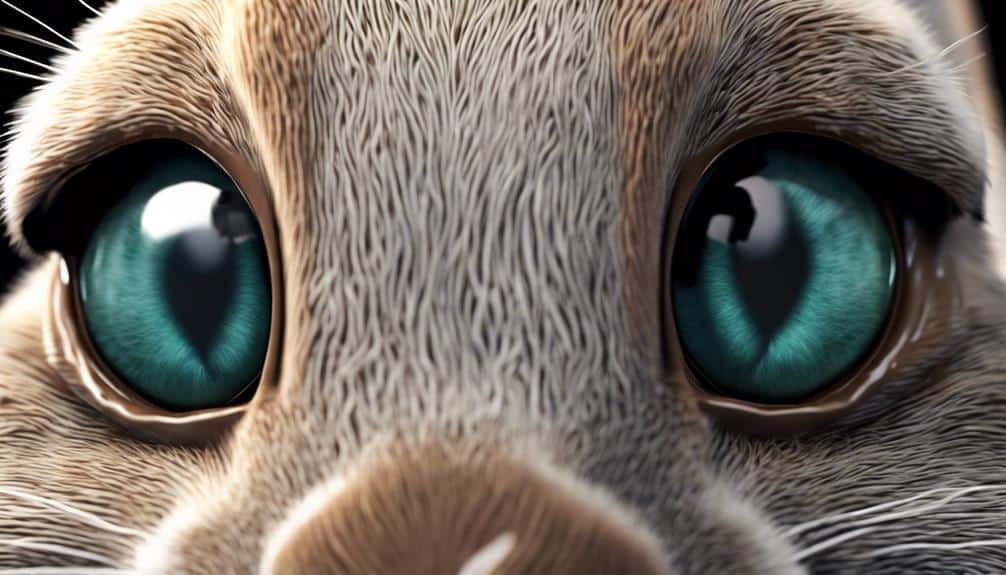
Bunnies possess a unique visual system characterized by a small blind spot in front of their face, necessitating reliance on other sensory cues for spatial awareness. This blind spot is a result of the positioning of their eyes on the sides of their head, enabling them to see nearly 360 degrees around them. However, this positioning creates a small area directly in front of their nose where they struggle to see. While rabbits can't see directly in front of them, they compensate for this limitation by using their excellent sense of smell, whiskers that help detect nearby objects, and teeth that aid in exploration.
Although rabbits have this blind spot, their vision is finely tuned for survival in the wild. They're farsighted, allowing them to detect predators from a distance. Their eyes are also adapted to primarily see in two dimensions, losing depth perception at close ranges. This specialized vision system helps rabbits stay vigilant and evade potential threats effectively.
Understanding Bunny Blind Spots
With eyes positioned on the sides of their head, rabbits exhibit a small blind spot directly in front of their faces, impacting their visual perception. Despite this limited field of vision, rabbits possess remarkable abilities to compensate for this minor limitation. Here's how they manage:
- Keen Sense of Smell: Rabbits rely heavily on their sense of smell to gather information about their surroundings. This heightened olfactory sense allows them to detect food, predators, and other animals even when they can't see them directly.
- Ability to Use Teeth: In addition to their sense of smell, rabbits use their teeth as a tool to explore objects within their blind spot. By nibbling and gnawing, they can gather tactile information and interact with their environment effectively.
- Nearly 360-Degree Vision: Rabbits' exceptional nearly 360-degree vision compensates for the blind spot in front of them. This wide field of view enables them to monitor their surroundings from various angles and respond to threats promptly.
Understanding how rabbits utilize their senses and unique visual anatomy helps caretakers make sure these animals can navigate their environment safely and thrive.
Exploring Bunny Color Vision
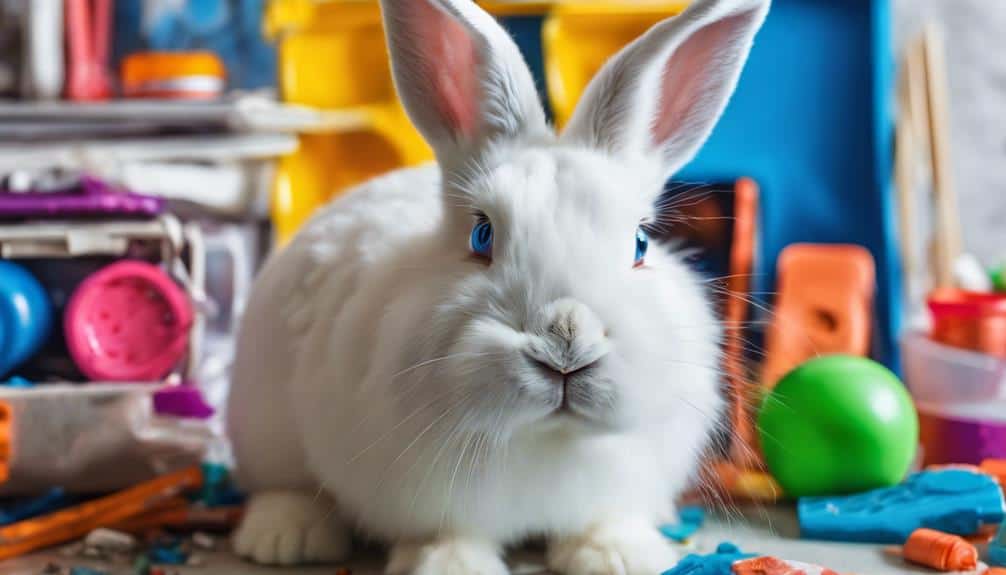
Rabbits' limited color vision, specifically their ability to distinguish between green and blue but not red, is essential in comprehending their perception of the environment. Unlike humans who've three types of cones for color vision, rabbits have only two types, making them dichromatic.
Their retina cells consist of more rods than cones, enhancing their vision in low light conditions. Due to the absence of specific cone cells, rabbits are unable to see red wavelengths. To compensate for this limitation, rabbits heavily rely on their acute sense of smell and whiskers for navigation and detecting predators.
Understanding the color vision of rabbits is vital for designing enriching environments that cater to their unique visual abilities. By incorporating colors within the green and blue spectrum, their surroundings can be optimized to suit their color vision limitations, ensuring they can thrive in their environment.
Perception of Objects in Front
In the visual perception of objects directly in front of them, rabbits exhibit a unique adaptation due to the positioning of their eyes. Here's how they manage to perceive their surroundings even with a blind spot right in front of them:
- Rabbits eyes are located on the sides of their head: This positioning creates a blind spot directly in front of them, but it allows for nearly 360-degree vision, helping them detect predators from various angles.
- Farsightedness aids in predator detection: While rabbits may lose depth perception at close ranges and primarily see in two different categories, their farsightedness enables them to spot potential threats from a distance, enhancing their survival instincts.
- Reliance on other senses: To compensate for the blind spot, rabbits heavily rely on their sense of smell, whiskers, and teeth to navigate their environment and interact with objects near their face.
Face Recognition in Bunnies
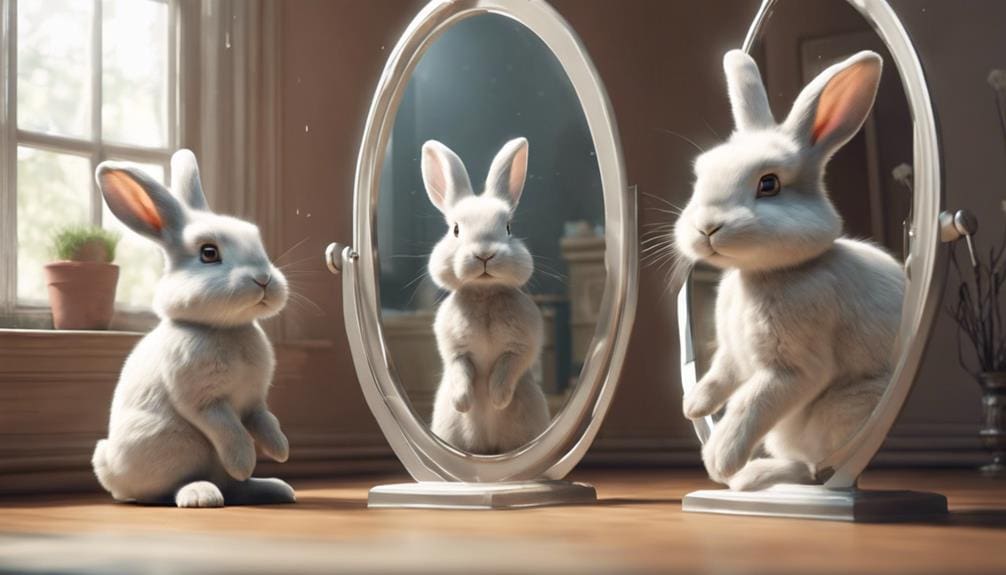
Bunnies possess a remarkable ability for facial recognition, distinguishing familiar individuals by their unique features. Their visual perception skills enable them to identify subtle differences in faces, aiding in social interactions and bonding within their groups.
Understanding how bunnies recognize faces can deepen our appreciation for their complex social behaviors and strengthen the human-animal bond.
Bunny Facial Recognition
Facial recognition in rabbits involves utilizing multiple sensory cues to identify familiar faces and distinguish between individuals. When it comes to bunny facial recognition, they rely on various cues to compensate for their blind spot directly in front of them.
- Sense of Smell: Rabbits use their keen sense of smell to recognize familiar faces through scent cues.
- Whiskers and Teeth: Their whiskers and teeth play a vital role in gathering information about objects in front of them.
- Interactions and Communication: By combining these sensory cues, rabbits can establish meaningful interactions and effective communication with other individuals, even without clear visual perception.
Visual Perception Abilities
Utilizing their keen sense of smell, whiskers, and teeth, rabbits compensate for their limited frontal visual field by relying on alternative sensory cues for close-range detection and facial recognition. Rabbits have a small blind spot directly in front due to the placement of their eyes, making them farsighted and losing depth perception up close. Their vision is limited to two-color vision, perceiving green and blue shades primarily. However, rabbits have more rods in their retinas, meaning they can see better in dim light conditions. To survive, rabbits rely on spotting predators from a distance, thanks to their high placement of the eyes. Understanding these unique visual abilities can enhance interactions and care for these animals.
| Visual Perception Facts | |
|---|---|
| Spot directly in front | ✓ |
| Perceive green and blue | ✓ |
| Means rabbits can see | ✓ |
| Rabbits see | ✓ |
| Rabbits have more rods | ✓ |
Rabbit Eyesight Myths Vs. Facts
Rabbit eyesight is a fascinating topic filled with myths and facts. These creatures have a nearly 360-degree field of vision, compensating for a small blind spot in front of their faces.
Despite their excellent distance vision, rabbits struggle with depth perception up close, primarily seeing in two dimensions.
Bunny Vision Range
In considering bunny vision range, it's essential to understand the unique characteristics of rabbit eyesight that distinguish between myths and facts.
- Rabbits have a blind spot in front of their faces due to the positioning of their eyes on the sides of their head.
- They rely on their whiskers, sense of smell, and teeth to compensate for the blind spot in front of them.
- The farsightedness of rabbits helps them detect predators from a distance rather than up close.
These features enable rabbits to navigate their surroundings effectively despite the limitations in their vision, showcasing their adaptive abilities in the face of potential threats.
Rabbit Depth Perception
With a small blind spot directly in front of their faces, rabbits rely on their unique sensory adaptations to navigate their surroundings effectively and detect potential threats. Despite this blind spot, rabbits possess nearly 360-degree vision, allowing them to see behind them without the need to turn their heads.
Their farsightedness plays a significant role in detecting predators from a distance, while their vision lacks depth perception up close. To compensate for the blind spot and challenges in depth perception, rabbits utilize their whiskers, sense of smell, and teeth.
Understanding rabbit vision and their depth perception can help in creating enriching environments for pet rabbits, ensuring their safety and well-being by considering their unique sensory abilities and vulnerabilities.
Frequently Asked Questions
How Far Can a Rabbit See in Front of Them?
In front of you, a rabbit's eyesight extends up to a few feet, with a focus distance of about 20 inches. Their wide field of view and peripheral vision aid in detecting movement, but close-up, depth perception diminishes.
What Do Bunnies Vision Look Like?
In bunnies, vision involves impressive night vision, keen peripheral sight, limited color perception, and compromised depth perception. Their exceptional motion detection, predatory instincts, camouflage detection, and visual acuity aid in foraging and predator evasion.
What Do Bunnies See Humans As?
When bunnies see humans, they perceive them as significant figures in their lives. Through animal perception, they recognize you by your movements, voice, and scent. Your care and positive interactions shape their emotional responses and companion expectations.
Do Rabbits See Straight Forward?
In their natural state, bunny eyesight focuses mainly on peripheral view for spotting danger. Their forward vision is limited, but their optic sense compensates with a clear line of sight for survival in the wild.
Conclusion
To summarize, bunnies have a unique visual system that allows them to navigate their surroundings effectively despite having a blind spot in front of them. Their keen sense of smell, whiskers, and teeth compensate for this limitation, showcasing their adaptability in the wild.
Just like bunnies rely on their senses to overcome obstacles, we too can learn to navigate challenges by trusting our instincts and utilizing our strengths to overcome any blind spots in our path.


